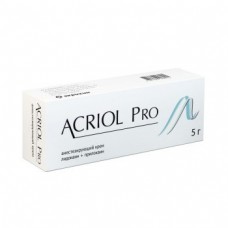Expiration date: 06/2026
INN: lidocaine + prilocaine
Pharmacotherapeutic group: local anesthetic means
Indications for use
Adults:
surface anaesthesia of the skin with injections (including vaccines), puncture and catheterization of blood vessels and superficial surgical procedures, including cosmetic procedures and hair removal;
surface anesthesia of trophic ulcers of the lower limbs during surgical treatment;
surface anaesthesia of the mucous membrane of the genital organs prior to conducting painful procedures and for analgesia before injections of local anesthetics.
Children:
surface anaesthesia of the skin with injections (including vaccines), puncture and catheterization of blood vessels and superficial surgical procedures (i.e. removal of molluscum contagiosum).
Contraindications: hypersensitivity to local anesthetics of the amide type or to any component of the drug.
Premature neonates born with gestational age less than 37 weeks.
Newborns weighing less than 3 kg.
Use during pregnancy and breastfeeding
Pregnancy
Insufficient data on the use of the drug in pregnant women
Breastfeeding
Lidocaine and prilocaine are excreted in breast milk in amounts that do not pose a risk to the child when using the drug in therapeutic doses.
Method of application and doses
Externally, on the skin or mucosa. When performing the surface anesthesia of intact skin, the preparation is 1.5-2 g/10 cm2 be applied in a thick layer on the skin and cover occluzionna bandage. The maximum recommended dose of 60 g, the maximum recommended area of application 600 cm2. Duration of application – 1 hour, maximum 5 hours
Surface anesthesia of trophic ulcers of the lower extremities
During surgical treatment (mechanical cleaning) of trophic ulcers of the lower extremities: a single dose of about 1-2 g/10 cm2; apply a thick layer of cream on the ulcer surface, not more than 10 g of cream for the procedure. To put an occlusive dressing.
Application time: at least 30 min.
Surface anaesthesia of the genital organs
Genital skin:
Anesthesia before the injection of local anesthetics:
Men: 1 g/10 cm2. Apply a thick layer of cream on the skin. Application time: 15 min.
Women: 1-2 g/10 cm2. Apply a thick layer of cream on the skin. Application time: 60 min.
Surface anaesthesia of the mucous membrane of the genital organs:
When removing warts and analgesia before injection of local anesthetics: about 5-10 grams, depending on the size of the treated surface. The cream should be applied to the entire mucosal surface, including the folds of the mucous membrane. An occlusive bandage is not required. Application time: 5-10 min. to Carry out the procedure immediately after removal of cream.
Children
Apply a thick layer of cream on the skin and cover occluzionna bandage. The dose should correspond to the machined surfaces and should not exceed 1 g of cream per 10 cm2. Duration of application – 1 hour. For children up to 3 months. – important: no more than 1 hour.
Side effects
The following adverse reactions are distributed in frequency of occurrence as follows: very common (? 1/10); often (? 1/100, < 1/10); uncommon (? 1/1 000, < 1/100); rare (? 1/10 000, < 1/1 000), very rarely (<1 10="" 000="" br="">When applied to intact skin
Violations of the skin and subcutaneous tissue: often – transient local reactions in the area of application of the drug, such as paleness, redness and swelling; rarely, in the first moment after application, a slight burning, itching and feeling of warmth (in the area of application of the drug).
General disorders injection site: rarely, allergic reactions in the most severe cases – anaphylactic shock; methemoglobinemia and/or cyanosis. Reaction in the field of application of the drug, such as hemorrhagic rash or petechiae, especially after long-term application in children with atopic dermatitis or molluscum contagious. Irritation of the cornea due to accidental falling cream in the eye.
When applied to trophic ulcers of the lower extremities
Violations of the skin and subcutaneous tissue: often – transient local reactions in the area of application of the drug, such as paleness, redness and swelling; in the first moment after application, a slight burning, itching and feeling of warmth (in preparation); rarely, skin irritation (in preparation).
General disorders injection site: rarely, allergic reactions in the most severe cases, anaphylactic shock.
Release form
Cream for local and external use, the 2.5 % + 2.5% 5, 30 or 100 g in aluminum tube
Storage conditions
At temperatures above 30 OC. Do not freeze. Keep out of reach of children.




